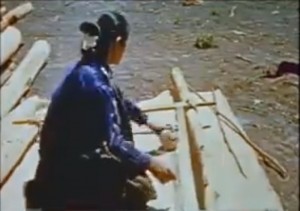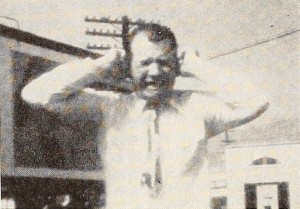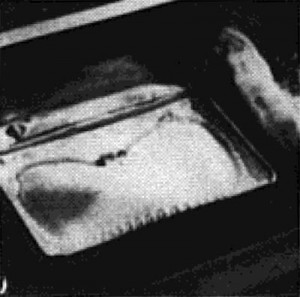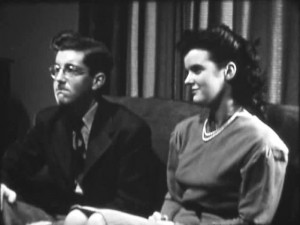
"E. Tad Nichols, III, born in the West, has been in the saddle almost since he first toddled. Much of his time has been spent among the Western Indians, and he has an intimate knowledge of their ways. So skillfully has he planned and edited each sequence of Navajo Rug Weaving that the audience has the rare satisfaction which comes from seeing just the right amount of each step of this ancient art that has held one method and course for many centuries. The direction and filming are of such excellence that the viewer almost seems to be present for the carding, spinning, dyeing and actual weaving of the rugs. Here is the human record film at its best." Movie Makers, Dec. 1945, 495.
"Un-staged documentary footage shot and edited by Sallie Wagner. Sallie's description of the film: 'Wide Ruins and area, farming Navajos, Black Rock - Medicine Man, Cut Hair plowing, Joe Toddy following Cut Hair, planting, Patsy Martin standing on Cultivator, Jim House's wife husking corn, Paul Jones helping husk corn, sheep dipping at Ganado, Dwight Wagner viewing sheep dipping, wool shearing at Wide Ruins, loading sheep at Chambers, tall man in tan outfit Bill Cousins, Bent Knee sitting on fence, Crip Chee's grandson in closing scene'." New Mexico States Archives.
"Part one of Navajo Weaving. Un-staged documentary footage shot and edited by Sallie Wagner. Sallie's description of the film: 'Crip Chee's Hogan, Milton Davis holding lamb, Eleanor Johnson from Hawaii, Bill Lippincott, Grandstaff (center), Hosteen Glish - purchase of rams for up-breeding, shearing at Wide Ruins, Jim House on horseback, Joe Toddy taking wool out for sorting and sacking for shipment, dipping in chute, Walter Ashley putting sheep in dip, Little Shorty to left, washing the wool before spinning, Patsy Martin sorting, Sybil Shorty carding wool, Dorothy Lippincott Stockton trying to learn, Louise Dale spinning wool, washing of yarn, gathering plants for dyes, Little Woman (Captive of Kit Carson - survived the Long March) grey-haired woman - stripping bark from Juniper root for red dye'." New Mexico States Archives.
"Part two of Navajo Weaving. Un-staged documentary footage shot and edited by Sallie Wagner. Sallie's description of the film: 'Rose Martin, Patsy Martin warping, Sybil Shorty weaving, looms built by the Lippincotts at the Wide Ruins Indian School, Madge Clark, Dan Gaddy, and John Joe in front of the trading post, Bill Lippincott in patio with rug display, Bill Cousins selling rug to tourist'." New Mexico State Archives.
"'Navajoland' entered by Richard V. Thiriot, of Salt Lake City, is a travelogue on that part of the great Southwest where dwell the dwindling and not-to-well-off Navajos. Thiriot has caught the beauty of this colorful country with his camera and Kodachrome film, and concludes the picture with intimate shots of some of the Indians who inhabit Navajoland. Had Thiriot been able to schedule his filming during the stormy weather season and thus been able to capture the colorful skies abounding in Navajoland at that time of the year, his photography would have greater pictorial interest, highly neccesary where subject material is predominantly static. Thiriot used a Filmo 70-DA and Kodachrome film." American Cinematographer, Apr. 1950, 145.

"Believing that he has been betrayed by his wife, the slightly Milquetoast lead character of Near Miss tries all imaginable methods of committing suicide — but without success. In presenting this simple saga of frustration, Barry W. Dance exhibits effective camera viewpoints, uniform exposures, convincing acting and a progression from one scene into the next which is done with precision and pace. Above all he preserves good taste in his plot episodes — a gracious accomplishment all too often slurred over in the strain for comic effect. Near Miss is a pleasant and entertaining farce." Movie Makers, Dec. 1952, 340.

"Excellent casting, artful direction, a true story in a natural setting - blend these ingredients together, add a touch of suspense, and edit until well done. This recipe, carefully followed, has provided a well-balanced film, guaranteed to please the appetite of any audience. An outstanding club production" PSA Journal, Oct. 1963, 41.

At home in the evening, a sophisticated young woman entertains an awkward male friend of her brother. They make small talk and dance to records -- but the boy's social anxiety overwhelms him, and he disappears in a puff of her cigarette smoke. (D.J. Duffy)
"Title, 'Nequasset Bridge is on new location of Route 1 near the famous ship-building city of Bath.'" oldfilm.org
"In this film record set in the beautiful Cumbrian countryside, sheep shearing and other farming activities take second place to fun. Whether swimming and splashing in a stream, feeding lambs, or taking a rowing boat out on the lake, there is plenty to keep children - and adults - busy. And of course we mustn't forget that essential outdoor activity - a picnic in the sunshine and fresh air." (BFI Player)
Total Pages: 203